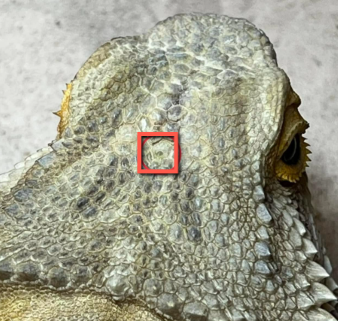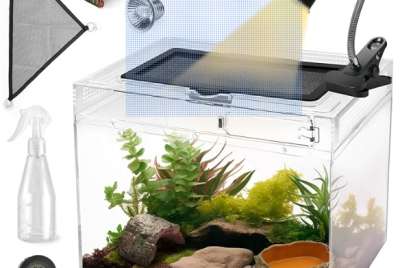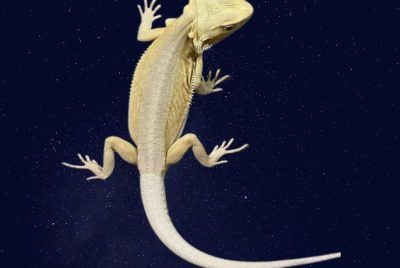Bearded Dragon 3rd Eye: Everything You Need to Know
When I first learned about the “third eye” on my bearded dragon, I was blown away. At first, I thought it was just a quirky name or some kind of myth. But as I dug deeper, I realized this tiny feature is one of the coolest—and most misunderstood—things about beardies. Let me walk you through everything I’ve learned so you can better understand your dragon and care for them the way they deserve.
What Is the Bearded Dragon’s 3rd Eye?
Scientific Name and Location
The third eye, also known as the parietal eye, sits right on top of your bearded dragon’s head, between its two regular eyes. It looks like a small gray or clear scale, almost like a faded dot.
How It Differs from Regular Eyes
Unlike the two eyes on the sides of its head, the third eye doesn’t form images. Instead, it detects light, shadows, and movement from above. Think of it as a built-in motion detector rather than a regular eyeball.
Why Do Bearded Dragons Have a 3rd Eye?
Evolutionary Purpose
This eye isn’t just for decoration—it’s a survival tool that has evolved over time. Many reptiles, amphibians, and even some fish have it, which suggests it plays a crucial role in staying alive.
Survival Advantages in the Wild
In the wild, a bearded dragon’s third eye helps spot predators like birds swooping down from above. By detecting sudden shadows, it gives them a chance to dart away and hide.
How the 3rd Eye Works
Detecting Shadows and Movement
Ever noticed your beardie suddenly dash when something passes overhead? That’s the third eye at work. It can sense changes in light and shadows instantly.
Role in Temperature and Light Sensing
The parietal eye also helps regulate circadian rhythms—basically, their internal body clock. It tells them when it’s day or night and helps with brumation cycles.
Connection to Their Behavior
Sometimes beardies act skittish or stressed when there are quick movements near their enclosure. That’s not them being “dramatic”—their third eye is simply on high alert.
Myths vs. Facts About the 3rd Eye
Common Misconceptions
Some people think the third eye gives beardies “psychic powers” or lets them see the future. Fun as that sounds, it’s not true.
What Science Actually Says
In reality, the third eye is just a specialized organ for light detection. It doesn’t see like regular eyes, but it’s crucial for survival and well-being.
Impact of the 3rd Eye on Captive Bearded Dragons
How It Affects Their Behavior in Tanks
In captivity, beardies don’t need to worry about predators, but their third eye still picks up shadows and changes in light. If you walk past the tank or move something above them, it can trigger their flight response.
Stress Responses and Shadow Detection
If your dragon suddenly darts, flattens out, or darkens its beard when nothing obvious is happening, their third eye may have sensed something above.
Importance of Proper Lighting in Captivity
Since the third eye helps regulate natural cycles, consistent UVB and day-night lighting patterns are essential. Without them, your beardie can get stressed or even sick.
How to Care for a Bearded Dragon Considering Its 3rd Eye
Providing the Right UVB and Heat
Make sure you use high-quality UVB bulbs and give your beardie 10–12 hours of consistent light daily. This mimics their natural environment and keeps their biological rhythms in check.
Avoiding Sudden Shadows and Overhead Stressors
Try not to wave your hand over the tank suddenly or place the enclosure where people constantly walk by overhead. That can make them feel like predators are around.
Creating a Comfortable Habitat
Add hides, branches, and basking spots so your beardie feels safe. A comfortable habitat reduces the chance of stress reactions triggered by the third eye.
Observing the 3rd Eye in Action
Real-Life Examples from My Own Beardies
One of my dragons, Spike, used to freak out whenever I carried laundry past his tank. It took me a while to realize the shadows were triggering his third eye. Once I moved his tank to a calmer spot, he relaxed.
What Owners Should Pay Attention To
If your beardie seems nervous without reason, consider what’s happening above their enclosure. Ceiling fans, overhead lights, or sudden movements might be stressing them out.
Do All Reptiles Have a 3rd Eye?
Other Species with Parietal Eyes
Yes, other reptiles like iguanas and some lizards also have a parietal eye. Even some fish and amphibians share this fascinating feature.
Why It’s Special in Bearded Dragons
What makes beardies unique is how noticeable their third eye is and how strongly it affects their daily behavior compared to other pets.
The 3rd Eye and Bearded Dragon Health
Can It Get Injured or Infected?
The third eye is covered by a protective scale, so injuries are rare. Still, if you notice swelling, redness, or unusual marks around that area, a vet check is a good idea.
What to Do If You Notice Issues
If your dragon rubs its head excessively or shows signs of discomfort near the third eye, consult a reptile vet. Better safe than sorry.
Why Understanding the 3rd Eye Makes You a Better Owner
Building Trust With Your Beardie
When you understand why your dragon reacts to shadows or sudden movements, you stop taking it personally. This helps you build trust and handle them with more care.
Improving Their Quality of Life
Knowing about the third eye means you’ll design their tank better, handle them more gently, and create a calmer environment. All of this adds up to a healthier, happier beardie.
The bearded dragon’s third eye might seem like a small dot on their head, but it plays a massive role in their survival and well-being. From detecting predators in the wild to regulating their daily rhythms in captivity, this little organ is nothing short of amazing. By respecting its purpose and adjusting how we care for them, we make life easier and more natural for our scaly friends.
FAQs
1. Can bearded dragons actually see through their third eye?
Not exactly—they don’t see images but can detect light and shadows.
2. Does the third eye mean my beardie can sense danger?
Yes! In the wild, it helps them detect predators from above.
3. Can I accidentally hurt the third eye while handling my dragon?
It’s protected by a scale, so casual handling won’t hurt it.
4. Why does my beardie freak out when I walk past the tank?
Their third eye may be sensing your shadow as a predator threat.
5. Do all bearded dragons have a third eye?
Yes, all species of bearded dragons have this parietal eye.




